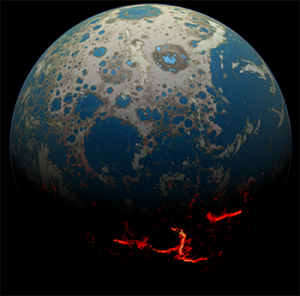Dec 8 2015
During the formation of the solar system, two waves of planetary bombardment likely played a significant role in planetary evolution. The calm between the barrages is the focus of an invited lecture that Dr. William Bottke, a planetary scientist from Southwest Research Institute, is presenting at the American Geophysical Union (AGU) Fall Meeting, Dec. 14, at 4 p.m. Pacific Time in San Francisco.
 This illustration shows how the early Earth might have looked under bombardment, with circular impact features dotting the daylight side, while hot lava glows on the night side. Image Courtesy of Simone Marchi (SwRI), SSERVI, NASA
This illustration shows how the early Earth might have looked under bombardment, with circular impact features dotting the daylight side, while hot lava glows on the night side. Image Courtesy of Simone Marchi (SwRI), SSERVI, NASA
"It is a great honor to be asked by the AGU to give a lecture named after Gene Shoemaker," said Bottke, who is director of SwRI's Space Studies Department in Boulder, Colo., and also serves as director of the Institute for the Science of Exploration Targets, a founding member of NASA's Solar System Exploration Research Virtual Institute. "I knew Gene, and I consider him to be one of my scientific heroes."
His lecture will explore the evidence for a relatively tranquil time between two violent bombardment phases in the early solar system. The first is an early period when newly formed worlds were struck by leftover bodies. After a respite interval, evidence points to a violent reshuffling of the planets around 4 billion years ago that destabilized the asteroid belt and caused a later heavy bombardment period. Bottke will synthesize and interpret information from a variety of sources to support this proposed series of events. Evidence is provided by planet formation models; ancient samples derived from asteroids, Mars, the Moon, and Earth; and gravitational and topographic field data from the Moon and Mars.
"The Calm Before the Storm: Exploring the Post-Accretionary Doldrums Prior to the Late Heavy Bombardment," is the title of the 2015 Shoemaker Lecture. The presentation is one of AGU's series of Bowie lectures associated with the William Bowie Medal, its highest honor. Named for medal recipient Eugene Shoemaker, this lecture is presented by an outstanding geologist or planetary scientist selected for contributions to the understanding of impact craters and lunar science.